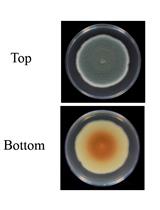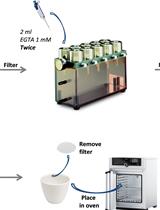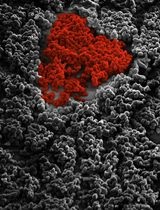- EN - English
- CN - 中文
Intracellular cAMP Measurements in Candida albicans Biofilms
白念珠菌生物膜细胞内cAMP的测定
发布: 2019年12月05日第9卷第23期 DOI: 10.21769/BioProtoc.3461 浏览次数: 4313
评审: Alexandros AlexandratosSadri ZnaidiMichael Tscherner
Abstract
Candida albicans is the most common cause of fungal infections worldwide. Infection by C. albicans is closely associated with its ability to form a biofilm, closely packed communities of cells attached to the surfaces of human tissues and implanted devices, in or on the host. When tested for susceptibility to antifungals, such as polyenes, azoles, and allylamines, C. albicanscells in a biofilm are more resistant to antifungal agents than C. albicans cells in the planktonic form. Cyclic Adenosine monophosphate (cAMP) is one of the key elements for triggering hyphal and biofilm formation in C. albicans. It is hard to detect or extract molecular markers (e.g., cAMP) from C. albicans biofilms because the biofilms have a complex three-dimensional architecture with an extracellular matrix surrounding the cell walls of the cells in the biofilm. Here, we present an improved protocol that can effectively measure the level of intracellular cAMP in C. albicans biofilms.
Keywords: Candida albicans (白色念珠菌)Background
Candida albicans is a member of the fungal community in the human gastrointestinal tract, mouth, and genital tract. C. albicans does not only cause superficial diseases, but also systemic infections in immunocompromised patients (Brown et al., 2012; Kim, 2016; Lohse et al., 2018). In clinical infections of C. albicans, the fungal cells commonly form biofilms; C. albicans biofilms are associated with chronic infection and antifungal resistance (Rajendran et al., 2016). The cyclic adenosine monophosphate (cAMP) signaling pathway has been considered to be one of the most important signal transduction pathways that can cause a switch from budding to hyphal morphogenesis, a switch to hyphal growth promotes biofilm formation and invasive growth in C. albicans (Wang, 2013; Tao et al., 2017). Activation of adenylyl cyclase to produce cAMP is thought to promote hyphal induction, and maximal levels of cAMP coincide with maximal germ tube formation (Parrino et al., 2017). In brief, it is generally accepted that biofilm formation of C. albicans requires elevated levels of cAMP. Therefore, measurement of cAMP levels in C. albicans biofilms is important to understand biofilm formation and antifungal drug resistance and has the potential to be an important reference value for future drug development efforts.
C. albicans biofilms are comprised of complex, surface-associated cell populations embedded in an extracellular matrix (Lohse et al., 2018). The three-dimensional hyphal structure of biofilms and the matrix surrounding the cells serve as physical barriers that make it difficult to detect or extract specific molecular markers such as cAMP from C. albicans biofilms. Yun et al. (1998) presented a method of to measure the intracellular cAMP level of planktonic Saccharomyces cerevisiae; however, no protocol has been reported on how to measure the level of intracellular cAMP in C. albicans biofilms. This article provides an improved protocol to measure the intracellular cAMP level of C. albicans biofilms. In this protocol, the levels of intracellular cAMP of cells within biofilms are examined by using an enzyme-linked immunosorbent assay (ELISA) with modifications; this is a modification of the method originally described in Yun et al. (1998).
Materials and Reagents
- Stainless steel tweezer (Thermo Fisher Scientific, Thermo ScientificTM, catalog number: DS0399-0001)
- Pipettes (Eppendorf, P1000, catalog number: 3120000062; P200, catalog number: 3120000054; P10, catalog number: 3120000020; P2.5, catalog number: 3120000011, respectively)
- Flasks (Duran, 50 ml, catalog numbers: 21-216-17; 100 ml, catalog number: 21-216-24, respectively)
- Cell culture dish (Thermo Fisher Scientific, Thermo ScientificTM, NuncTM EasYDishTM, catalog number: 150466)
- 1.5 ml microtubes (Axygen®, catalog number: MCT-150-C)
- Tubes (Eppendorf, 15 ml, catalog number: 0030122151; 50 ml, catalog number: 0030122178, respectively)
- Cell scraper (Costar, catalog number: 3010)
- Pipette tips (Eppendorf, 1,000 µl, catalog number: 0030000919; 200 µl, catalog number: 0030000870; 10 µl, catalog number: 0030000811, respectively)
- Aluminum foil
- Parafilm
- Strain (Candida albicans, SC5314) (ATCC, catalog number: 10231)
- Yeast extract (BD Biosciences, catalog number: 212750)
- Peptone (BD Biosciences, catalog number: 211677)
- Dextrose (BD Biosciences, catalog number: 215530)
- Agar (BD Biosciences, catalog number: 214040)
- RPMI 1640 medium (Sigma-Aldrich, catalog number: R6504)
- Sodium phosphate monobasic monohydrate (Thermo Fisher Scientific, catalog number: S369-500)
- Sodium phosphate dibasic anhydrous (Thermo Fisher Scientific, catalog number: BP332-500)
- Sodium chloride (Thermo Fisher Scientific, catalog number: S671-3)
- Sodium hydroxide (NaOH) (Sigma-Aldrich, catalog number: 59223C)
- Distilled water
- 2-(N-Morpholino)ethanesulfonic acid (MES) (Sigma-Aldrich, catalog number: M5287)
- Trichloroacetic acid (Sigma-Aldrich, catalog number: T9159)
- Ice
- Liquid nitrogen
- YPD medium
- Ether (Sinopharm Chemical Reagent Co., Ltd, catalog number: 10009318)
- cAMP Enzyme Immunoassay Kit (Sigma-Aldrich, catalog number: CA200)
- Goat Anti-Rabbit IgG Coated 96-well
- cAMP-Alkaline Phosphatase Conjugate
- cAMP EIA Antibody Rabbit Anti-cAMP
- 0.1 M Hydrochloric Acid
- 0.1 M HCI in water
- Neutralizing Reagent
- Wash Buffer Concentrate
- Cyclic AMP Standard
- p-Nitrophenyl Phosphate Substrate Solution
- Stop Solution
- Triethylamine
- Acetic Anhydride
- Plate Sealer
- MES Buffer (see Recipes)
- Sabouraud dextrose agar medium (SDA) (see Recipes)
- YPD broth (see Recipes)
- YPD agar medium (see Recipes)
- 1x PBS (see Recipes)
Equipment
- Ultrasonic cell crusher (Celton, model number: UH-500B)
- 30 °C shaking incubator (Infors, model number: Multitron Standard)
- CO2 incubator (ESCO, CelMate®, model number: CLM-170B-8-NF)
- Multiwell plate shaker (Thermo Fisher Scientific, Thermo ScientificTM, SorvallTM ST 40R, catalog number: 75004524)
- Multi-mode Microplate Reader (Molecular Devices, SpectraMax M5)
- Autoclave
- Centrifuge
Procedure
文章信息
版权信息
© 2019 The Authors; exclusive licensee Bio-protocol LLC.
如何引用
Jiang, L., Chen, S., Sun, K., Zhou, P. and Wei, X. (2019). Intracellular cAMP Measurements in Candida albicans Biofilms. Bio-protocol 9(23): e3461. DOI: 10.21769/BioProtoc.3461.
分类
微生物学 > 微生物生物化学 > 其它化合物
微生物学 > 微生物生物膜 > 生物膜培养
生物化学 > 其它化合物 > 环磷酸腺苷(cAMP)
您对这篇实验方法有问题吗?
在此处发布您的问题,我们将邀请本文作者来回答。同时,我们会将您的问题发布到Bio-protocol Exchange,以便寻求社区成员的帮助。
提问指南
+ 问题描述
写下详细的问题描述,包括所有有助于他人回答您问题的信息(例如实验过程、条件和相关图像等)。
Share
Bluesky
X
Copy link












